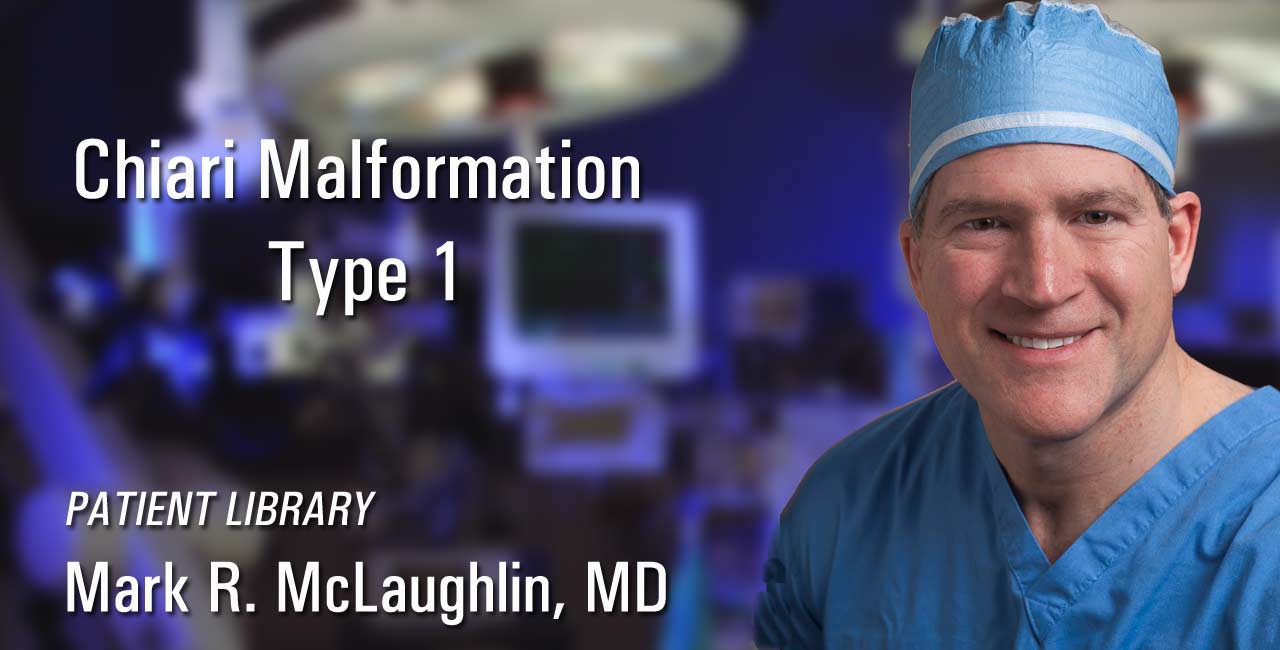Chiari Malformation Type 1

Introduction to Chiari Malformation
By Mark R. McLaughlin, MD, FACS, FAANS
Chiari malformation is a condition in which brain tissue protrudes into the spinal canal. As a result of the obstruction of the normal pathways of cerebrospinal fluid (CSF), a build up of fluid on the brain (hydrocephalus) or in the spine (syringomyelia) may occur. Although Chiari malformation is uncommon, modern imaging techniques and comprehensive exams have allowed physicians to begin making more accurate diagnoses.
Chiari Malformation Type 1 is one of the four most common types of the condition. Patients with type 1 typically do not have symptoms until late childhood or adulthood. This is because the malformation does not develop until the skull and brain are growing. In contrast, patients with other types of Chiari malformation are often diagnosed in utero, during birth, or during early infancy.
Symptoms
The most common symptom of Chiari Malformation is Occipital headache. Additional symptoms of Chiari malformation type I may include tinnitus, nausea, facial pain, difficulty swallowing, visual symptoms, or muscle weakness. Untreated Chiari malformation type 1 may also result in the development of fluid filled cavities in the brain (hydrocephalus) or spinal cord (syrinx) which may eventually lead to syringomyelia. This can lead to irreversible damage to the brain or spinal cord.
Additional symptoms associated with a Chiari Malformation may include poor coordination and balance problems, muscle weakness, or difficulties speaking (dysarthria), palpitations, fainting episodes (syncope) and tingling or burning sensations in the fingers, toes or lips (paresthesias). Sleep disorders, especially sleep apnea and chronic fatigue, have also been noted in individuals with Chiari malformations
Although Chiari malformation occurs in 1 of 2,000 people, the number of patients who exhibit symptoms is significantly less.
Diagnosis
The diagnosis of Chiari malformation type 1 is made through a combination of patient history, neurological examination, and Magnetic Resonance Imaging (MRI). Special flow MRI scans called CINE studies are sometimes necessary to make the diagnosis. Additional imaging techniques that may be used involve the use of 3-D CT imaging of the brain and skull. Early diagnosis of Chiari malformation type 1 can lead to treatment before the formation of syrinx.
Some patients may have a condition related to syringomyelia known as hydromyelia, which is characterized by an abnormal widening of the central canal of the spinal cord. This is the small canal that runs through the center of the spinal cord. These small cavities are filled with cerebrospinal fluid and their use is not known. Some doctors use the terms syringomyelia or hydromyelia interchangeably. However, they are in fact different conditions. Hydromyelia cavities connect to the fourth ventricle (an area in the brain that normally contains cerebrospinal fluid). Hydromyelia may also be present in infants and young children with or without brain abnormalities. The fluid-filled cavities in cases of syringomyelia often do not connect to any other fluid-filled areas or spaces and occur more often in adults than children.
Treatment
There is no cure for the malformation, however treatment can help relieve the symptoms. The treatment of Chiari Type 1 will be based on a number of factors including the severity of symptoms and whether or not syrinx exists. When the patient has no symptoms or neurological findings, doctors will often manage the condition by observation only. When the patient has symptoms that are mild but manageable, a physician may prescribe medications to help reduce the pain.
Surgery may become necessary if a patient notices symptoms that are progressive, observes a decline in neurological function, and/or experiences an enlarging syrinx. When surgery is required, the surgery typically begins by making an incision in the middle of the back of the skull, which extends midway down the back of the neck. Muscles are gently separated from the base of the skull as well as from the back of the first cervical vertebra.
After the muscles have been separated, a craniectomy is performed to enlarge the opening of the base of the skull and create additional CSF flow space next to the brain. To do this, a specialized surgical instrument is used to carefully shave a small piece of bone about the size of a silver dollar. The first cervical vertebra is then carefully removed during a procedure called a laminectomy. In some cases, removal of additional cervical lower lamina may be necessary.
Conclusions
Patients with Chiari malformation type 1 are often asymptomatic, and only learn that they have the condition after it is incidentally found during an evaluation for other non-related conditions.
Once a Chiari malformation is diagnosed, it is important to get an evaluation by a neurosurgeon with experience in the treatment of Chiari. Early diagnosis and treatment of this condition is critical. Surgical treatment for symptomatic Chiari malformation type 1 is usually very successful when treated promptly. Many patients experience significant improvements in their symptoms after surgery and are able to return to daily life without activity restrictions.
Other resources include:
Chiari Malformation Factsheet at NIH
Chiari Malformation Overview at American Association of Neurological Surgeons
Chiari Malformation Information for Patients - Expert Princeton Neurosurgeon
Chiari Malformation and Syringomyelia
Chiari Malformation is a disorder in which certain structures in the brain fail to develop normally. SM is a disorder that develops when CSF enters the spinal cord and forms a cavity called a syrinx
Chiari Malformation: Symptoms and Treatment
Chiari Malformation is a complex and serious neurological disorder. Most patients exhibit multiple symptoms, however some with Chiari Malformation will have no symptoms at all.





